A scientist with heart and soul
We could imagine nothing pleasanter than to spend all of our lives digging for relics of the past.
Heinrich Schliemann
He started to learn about the secrets of the universe along with learning the
alphabet, and astronomy became his lifelong hobby, but not his profession. He
devoted many years to meteor astronomy, nowadays he prefers flyovers of artificial
satellites. He observes, records and analyzes with the same precision artifacts
from the Stone Age as well as the movement of spacecraft around the Earth.
Patient, persevering and keen observer, scientist with heart and soul.
Marco Langbroek.
The town of Leiden is a place where the oldest university in the Netherland is
situated. Many renowned physicists, including Nobel laureates worked at the
university and for a certain period Albert Einstein gave lectures there too.
Leiden is also your birthplace and hometown. Although you graduated here, your
subject had nothing to do with natural sciences. What is your profession, your
day time job?
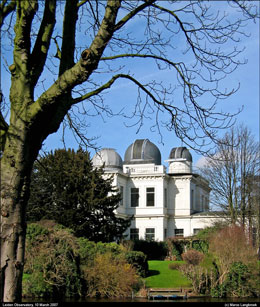
I am an archaeologist, specializing in the Palaeolithic: the archaeology of our earliest ancestors. Think Neandertals, handaxes, that kind of stuff. I got my MA and PhD in Leiden, have worked as a field archaeologist for two municipal archaeological services and now work as a post-doc researcher at the VU University in Amsterdam.
The former home of Ehrenfest where Einstein used to stay, a large now somewhat
dilapidated white house is not far from my home by the way, and so is the old
Observatory of Leiden. The latter is some 300 meters from my home.
As an archaeologist you are digging for relics of the past, but early in your
childhood you turned your searching look at the opposite direction, to the sky.
How did you discover astronomy?
My interest in astronomy started around 1976, when I was 6 years old. I had seen
broadcasts about the Viking landers on Mars, and then my parents bought a book
about the planets. It interested me, and when my parents noticed the interest
was staying, they made me a member of the Dutch Youth Association for Astronomy
(JWG) late 1978. In 1979, when I was 9, I built my first telescope, a 6 cm
refractor with a good achromatic lens and rainpipe tube under the guidance of
people of that club.
You were a passionate stargazer in your youth. Have you ever thought to be a
professional astronomer?
I always wanted to study astronomy, but I never was very good in mathematics,
so by the end of highschool I had to let go of that idea. I have always been
interested in history as well, so considered history as a study. Archaeology
sounded slightly more adventurous. So I choose archaeology and got my MA in
1998 and PhD in 2003.
Astronomy became one of my hobbies. The funny thing is of
course, that I would end up doing more or less both: astronomy and archaeology,
the one as a semi-professional amateur, the other as a professional. To my
archaeological colleagues, it is still very confusing when they discover that
I also have peer-reviewed astronomical publications on my name!
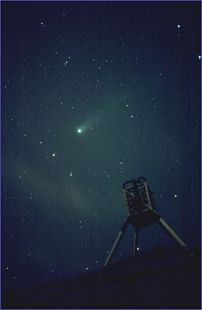
What were your favourite targets in the sky?
For several years I focussed on planets and deep-sky, first with the 6 cm, later
with a 4" Newtonian I bought from money I saved from the money my parents gave
me to buy schoollunches. I was quite active in the Youth Astronomy Association
at that time, became part of the editorial staff of its magazine 'Universum'.
At the age of 19 I was asked to fill a monthly column about deep-sky observing
with small instruments in Zenit, the largest Dutch astronomy magazine. I wrote
that column for several years. About the same time, my focus started to shift
however, to small objects in the solar system: comets, and meteors.
In the 1980´s there was an absence of big comets, none of them were bright enough,
and the return of "the old lady" 1P/ Halley was nothing extraordinary. Which
comets did you observe?
1P/Halley was my first comet, and I next observed some not too bright comets like
one of the Bradfield comets in '87 and a few others in the magnitude +4 to +7
range that appeared in the second half of the eighties. The absence of bright
objects untill Hyakutake and Hale-Bopp came along in the nineties was why I left
the field of comets again and switched to meteors. I actually searched for new
comets with my 4" Newton, visually, in the evening twilight sky for two years but
never found one.
You became a keen and very busy observer of shooting stars ...
From the nineties onwards, I completely turned to meteor astronomy. As a member
of the Dutch Meteor Society, I took part in large observing expeditions that
covered the Leonid outbursts of the nineties and early 2000's. It took us all
over the globe: Spain (1995, 1999, 2002), France (1996), Portugal (2000), the
USA (2001), and of course the Mother of all Expeditions: Northwest China in 1998,
a cooperation with the Chinese Academy of Sciences and NASA. That was very special:
observing the 1998 fireball outburst at -23 C and 3.5 km altitude from a remote
high desert on the edge of the Tibet-Qinghai plateau.
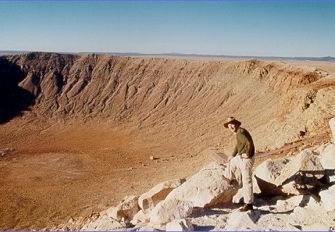
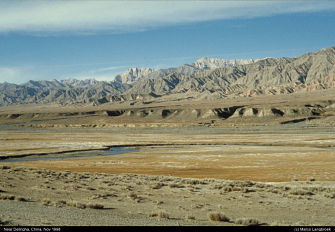
What did awake your interest in meteors?
In 1989, on an open day at the Leiden Observatory where the local chapter of our
Youth Astronomical Association volunteered, I met Peter Jenniskens. He has
played a major role in how my career as a high-level astronomy amateur took shape.
At that time he was a PhD in astronomy in Leiden and starting up his work in
meteor astronomy. He was my mentor in meteor work, and guided me into semi-professional
observing activities. As a result, I now have authored or co-authored several
peer-reviewed papers on meteor astronomy. Peter left the Netherlands in 1992
for NASA's Ames Research Center and subsequently became a well-known meteor
astronomer.
He is the person who organized the big NASA Airborne Campaigns with aircraft
with equipment during the Leonid meteor storms, and who organized the expedition
that recovered the first fragments of the 2008 TC3 asteroid impact in Sudan.
I owe much of what I have accomplished as a high-level amateur astronomer to him.

The meteor work had some spin-offs, partly because I have a very broad interest
which often makes me explore new issues. I started collecting meteorites (and
now have a nice collection of these, plus impact glasses and impact crater breccia),
and my interest in meteoric fireballs led to spin-off interests in asteroids
and satellite decays.
Meteor observation requires a lot of time, which is limited only to night hours.
How could you share your time for study and meteor observations, especially
during your expeditions around the world?
In my twenties I was a good multi-tasker. And when I was doing my PhD, I planned
my hollidays to coincide with major meteor campaigns.
Around 2004, I became very ill. Doing big meteor campaigns became too stressful.
Later, after I recovered from my illness, my work started to take more and more
of my energy too. So I turned to the much less tiring and time-consuming (but fun!)
business of satellite observations around 2005. In fact, almost all of my current
observing activities concerns satellites: I am part of a small international
(and rather informal) network of observers that do position determinations, and
from that orbit determinations, of classified satellites. These observations are
done from my home in the Leiden town center, mostly using a DSLR camera, a suite
of lenses, and astrometric software that was originally developed to measure
multistation meteor images.
It was also the time when you started your participation on pro-am asteroid
collaboration ...
My work with asteroids indeed started around the same time. In 2004, a fellow
amateur (Jeff Brower) introduced me to the Spacewatch FMO project that used
volunteers to review photographic plates taken at Steward Observatory on Kitt
Peak for Fast Moving Objects (FMO): Near Earth Asteroids! It meant that over
many 2004-2006 mornings, I started the day by starting up my computer, logging
in, and inspecting several images taken the previous hours with the 0.9 m
Spacewatch telescope. I inspected over 3000 images before, on 2005 April 9,
this led to my discovery of the Amor asteroid 2005 GG81
You were not only one of the most persistent volunteer but also administrator of
the FMO mailing list. How could someone became such an administrator?
Stu Megan had set it up, but at a certain moment decided to stop. I then offered
to take up the effort and constructed a new mailing list, as I felt the social
contacts among the FMO people which the mailing list and forum enabled, were a
very good thing.
Another field where you participated very intensely was asteroid searches in the
SkyMorph archive. How did you get knowledge of it?
Partaking in the same FMO project, and soon in the social network that sprang
from it, Rob Matson was the person who introduced it to others. He is the second
person, after Peter Jenniskens, who has been very important to me in introducing
me to and guiding me into a particular field of semi-professional astronomy. Rob
learned me how to extract images from the Skymorph archive, work with Astrometrica
to measure them, and use Findorb to chase the new objects we discovered in the
archive, leading to more images on more nights, and eventually to designations
issued by the Minor Planet Center (MPC).
What was the reason for starting your hunt?
Reasons were that it is fun to do, and it helped me fill cloudy evenings and
rainy Sundays. When satellites remained hidden behind clouds, the internet NEAT
archives at Skymorph became my hunting ground... I have a scientific mindset.
Obtaining new knowledge and 'discovery' has always been the bread and butter of
my life: it is why I became a scientist. It is part of my profession, and part
of my hobbies. I explore, observe, record, investigate, analyse...: whether it
are stone tools, geologic outcrops, asteroids, meteor activity, satellites,
dragonfly species around a pond....that really is me. Curiosity, and an urge to
explore new frontiers. There is still so much to discover on this world, and
in our skies!
There is another possibility to make discoveries using internet, similar to FMO
Spacewatch project - searching for SOHO comets. This challenge did not attract
you at all?
No, and I can't quite explain why. Somehow, it isn't that attractive to me.
Maybe because it lacks the astrometry and recovery through orbit fitting
procedures (it is merely detecting something on a SOHO image and reporting it).
You discovered 57 minor planets in the NEAT archive, many of them now got a
permanent number and even several were named. What is your most highly esteemed
result from the SkyMorph hunt?
The three Jovian Trojan asteroids I discovered are special (2001 SD355; 2002 WV27;
2002 WG29). It makes me feel like I am modestly following in the footsteps of the
famous Van Houtens, the Dutch astronomer couple working at Leiden Observatory
who during the sixties and seventies discovered most of the Jovian Trojans, using
the same Palomar telescope that NEAT employs. My most special discovery is however
not from Skymorph/NEAT, but from the FMO project: 2005 GG81. I never forget the
morning I saw that little trail pop up on the image, and got the message back
from Spacewatch that it had been submitted to the NEOCP (Near Earth Object
Confirmation Page).
Later, when you mastered how to search for unknown asteroids you wrote a "Guide"
which was very helpful to other hunters, including myself. After you were guided
by Rob Matson, later you passed it on others. Was it a satisfaction for you when
asteroid (183294) got the name "Langbroek" in your honour?
I felt very honoured by it. And it is good to hear that the guide I wrote has
been of use to others. It means it served its purpose!
Although you started your asteroid hunt in the time when the MPC did no longer
credit discoverers itself (as it was earlier), but the NEAT programme, you could
name 7 of your discoveries. How did you feel when you proposed those names to
the MPC?
I felt privileged that I could honour several deserving people in this way. The
names I proposed so far, concern either long-active, high-level amateur astronomers
from the field of meteors, asteroids and satellites, or some of my professional
"heroes" from palaeoanthropology (Eugene Dubois and Lewis Binford). It feels very
good to be able to honour people you admire for their contributions in this way.
You traveled almost all over the globe to watch meteor showers, is there still a
place on Earth which you would like to observe the sky from?
I have been privileged to observe from many places on this planet: in the remote
Qinghai province of China; the Arizona desert; Senegal; the mountains of Spain
(even on Calar Alto in 1995) and Switzerland; the countryside of France, Spain,
Portugal, Germany, Denmark and the Netherlands. I would like to observe the
southern meteor showers and the Magellanic Clouds once from Australia. That is
one thing on my 'to do' list.
What is your favourite astronomy book?
A special one to me will always be Carl Sagan's "Cosmos", derived from the TV-series
of the same name. I watched the TV series as a boy in the early eighties, and
it heightened my already awakened fascination with astronomy even more.
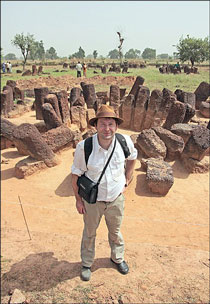
In contrast to many archaeoastronomy "specialists" and certainly fringe people a
lá Erich von Däniken, you are a real expert in both, quite different sciences,
in archaeology and astronomy. What do you think about archaeoastronomical theories?
I must say that in most cases I am very critical of archaeoastronomical studies,
especially those done by astronomers rather than archaeologists. Many of those
studies go over the top, over-interpret chance alignments and ignore the wider
archaeological context. They also frequently try to picture prehistoric humans
as "scientists", as observational astronomers, and put much too much emphasis on
"calendar functions" etcetera.
But I believe many allignments on midwinter suns etc. were never made to be
actually observed: they were created for the symbolism of it (much like the
buried Viking ships in ship burials were never made to actually sail in).
And prehistoric humans really didn't need a stone sightline to determine it was
time to start plowing and sowing rye or einkorn: they would know that from other,
environmental clues. Meticulous time-keeping and observations on meridian transits
are merely obsessions of our modern time, where meticulous time-keeping is
important while at the same time we have lost, in our western urban society at
least, contact with the significance of signs like returning birds and the blossom
date of flowers.
What does astronomy mean to you?
It is a part of my life and lifeworld that will always be there. Nothing reliefs
stress more than lying on your back under a dark star-spangled sky, watching
shooting stars and the milky way. I can't resist looking up whenever the sky is
clear.
Every Schliemann searches for his Troy. Is that of yours still hidden beneath the
soil or revolving somewhere in the of deep space?
Who knows? The interesting thing about both astronomy and archaeology is that you
cannot properly predict what you will find. So who knows what is in store? Only
time will tell!
Instead of an epilogue
In 2009 you stopped searching the NEAT archive after finding 57 asteroids. Then 3 years passed and
you started a new search, this time real time images from observatory Piskésztető in Hungary.
How did this happen?
In the summer of 2012 I joined the Piszkéstető (Konkoly, HU) asteroid survey of Dr. Krisztián Sárneczky
as a volunteer plate reviewer, looking by visual inspection of the images for objects that have been
missed by the automated plate inspection routines. The survey makes use of the Konkoly Mountain Station
(Hungary) 60 cm Schmidt telescope. This work is usually done in the evening hours. My first discoveries
in this survey were done during the October 2012 run. In February 2015, I discovered a NEA as part of
this survey: 2015 CA40.
The year of 2012 was full of exciting activities and unexpected events for you. In November,
out of the blue, you were awarded by the Royal Dutch Astronomy Association. What was that?
It was the annual Dr J. van der Bilt prize for my work on meteors, asteroids and meteorites. With
the prize money, I bought a Celestron C6.
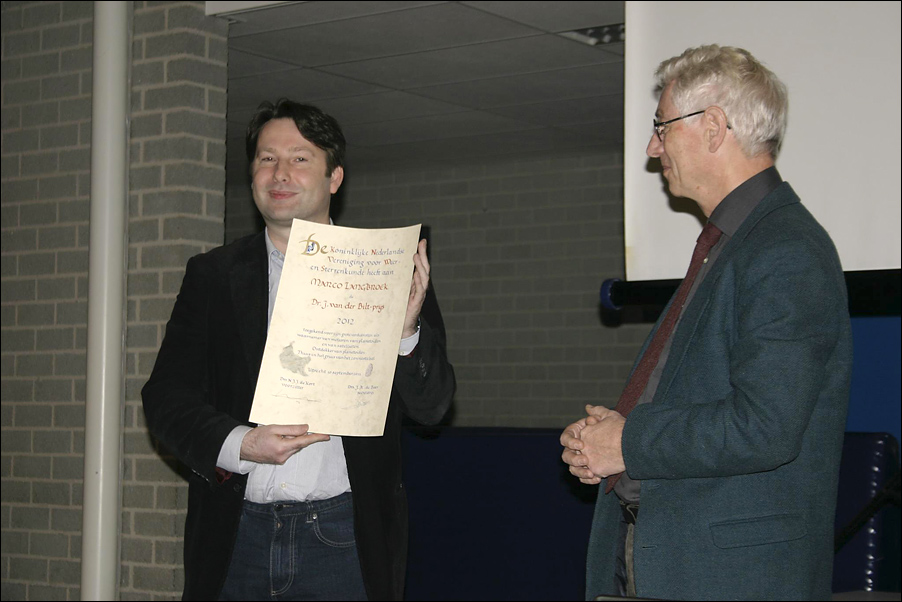
Instead of finding out what performance can offer your new telescope you started work on the Diepenveen meteorite.
Tell us about it.
Yes, that year I got also the opportunity to get involved into the research of a new and intriguing meteorite,
the Diepenveen carbonaceous chondrite. Eventually, this would lead to a research job at the Dutch National
Museum of Natural History from 2015 to 2017.
The story of that meteorite is decidedly unusual. It fell in October 1873, so 146 years ago now, but its existence
was completely unknown to science until 2012.
The meteorite fell in an agricultural field near the hamlet of Diepenveen in the east of the Netherlands. The fall
and impact was witnessed by field labourer Albert Bos and his wife, who picked it up and brought it to the village
teacher. The 68 grams stone ended up at the Higher Civilian School (HBS) of nearby Deventer town, where it entered
into a curiosa collection, that was soon completely forgotten. It probably spent the better part of a century gathering
dust in the attic of the school.
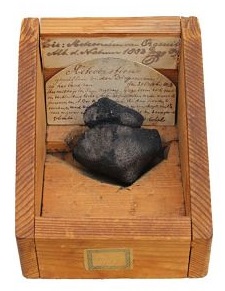
When the school was closed down almost 50 years ago, a teacher 'rescued' some stuff from the inventory that was
being thrown away: including a small wooden box with this meteorite in it. It sat decoratively on his fireplace
for many years, until he passed away. His widow then gave it to a friend of the family, Mrs Kiers, who collected
stones. She had it for years, not realising how special it was. Then serendipity played the joker in the summer
of 2012: as it happens, Mrs Kiers visits the same camping during summer holliday each year, and her neighbour on
that camping is Henk Nieuwenhuis, the retired curator of the historic Eise Eisinga Planetary in Franeker. When
Mrs Kiers organised an ad hoc exhibit of her stone collection, as part of some summer activities for the local
community, Henk spotted the box with the stone, and realised what it was. He contacted Niek de Kort, the then
president of the Royal Dutch Association for Astronomy, who agreed it looked genuine, and both of them next
contacted me.
I nearly got a heartattack when I got the pictures: not only was it clearly a genuine meteorite, but I immediately
recognized it as a rare carbonacous chondrite, meteorites that contain carbon compounds, sometimes including Amino Acids.
I started up research and classification of the Diepenveen, not realizing at that time that that research eventually
would grow very big, six years later resulting in a 31-page paper in Meteoritics & Planetary Science with me as main
author and 25 co-authors from 20 different international research institutions.
It landed me a temporary research position at Naturalis Biodiversity Center (the Dutch National Museum of Natural
History) in my hometown Leiden in 2015 and again in 2017. I am currently still a guest researcher at the museum.
So suddenly I found myself doing professional meteorite research, and working at a National Museum!
It turns out Diepenveen is a regolith breccia, a unique case, even among the already rare CM Chondrites.
Interestingly enough, the reflection spectrum of Diepenveen is similar to that
of asteroid Ryuku: the asteroid currently visited by the Hayabusa2 sample return mission. So, I am very
curious to see how the Ryugu samples compare to Diepenveen when the spacecraft resturns the samples in
December 2020.
In 2017, another new Dutch meteorite fall happened, at Broek in Waterland just a few km north of Amsterdam.
This was a fall which occurred in very early evening twilight of 11 january 2017. Two-and-a-half weeks later
Niek de Kort was contacted by a young couple that said that on the morning of 12 January (the day after the
fall), they had noted damaged roofing tiles at their garden shed, and found a blackened stone lodged in the
roof of the shed. We went to Broek in Waterland to investigate, on behalf of the museum. It was a 0.53 kg L6
chondrite, the sixth meteorite of my small country.
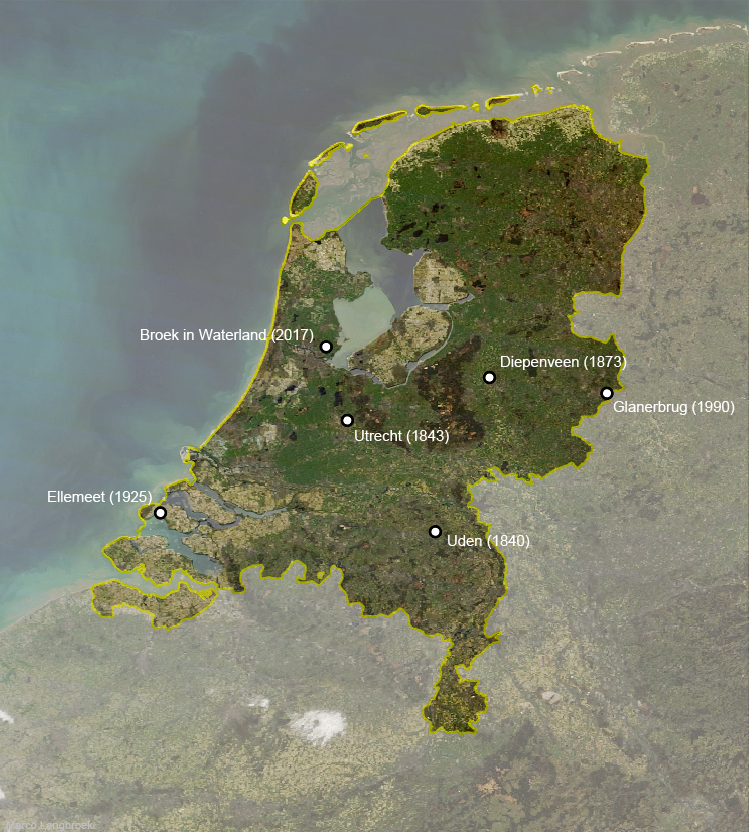
As you mentioned, since 2005 you have been tracking spy satellites, capturing their positions
and then determining orbits, which for obvious reasons are not made public. In 2014, great plane
accident shook the world. You were asked for help in connection with the investigation.
What was it about?
The catalyst was something horrible and dramatic: the shootdown of Malaysian Airlines flight MH17 over
the Ukraine on 17 July 2014. As we now know this civilian airliner was shot down by a Russian BUK
anti-aircraft missile, perhaps misidentifying it as a Ukrainian military aircraft. Of the 298 passengers
and crew that sadly lost their lives that day, 193 were fellow Dutch (and for me personally, it came
uncomfortable close because I would have flown the same route with the same airline only 3 days later).
I wrote a blogpost on my satellite blog (sattrackcam.blogspot.com) discussing which US infra-red early
warning satellites might have observed the missile firing. That was picked up by a Dutch Parliament member,
Pieter Omtzigt, who in January 2016 organized a hearing on MH17 of the Permanent Foreign Affairs Comittee
of Dutch Parliament, in which a number of relevant experts were heard by members of Dutch Parliament:
law experts, radar experts, Dutch Intelligence experts, crash investigators, the president of the European
association of Air Traffic Controlers etcetera. And he invited me as an expert to this hearing too, to brief
the committee on which (military) satellite systems might have observed the missile firing.
Only three days after that hearing, I was contacted by the Dutch Royal Air Force, by their brand new Space
Security Center. They were interested in my expertise with tracking classified satellites. A year later,
this resulted in a job, when I was enrolled as consultant on Space Situational Awareness issues to the
Space Security Center of the Royal Dutch Air Force. Interestingly enough, as the result of taking a broad
definition of "Space Situational Awareness', this project will incorporate Near Earth Asteroids as
well, although only as a 'byproduct' (we will be looking into
spectropolarimetric characterisation).
What are your activities besides strict and accurate science?
As a result of the above events, I started to be active in the media.Over the
past years, I have frequently (and increasingly so) appeared in Dutch and international newspapers,
and frequently on tv programs and in radio programs related to my activities: on topics ranging
from asteroids to meteorites to satellites to North Korean missiles. I have been a guest in several
Dutch prime-time nation-wide television programs, and on US TV in a PBS documentary by Miles O'Brien
on OSINT investigation of North Korean missile launches. I have done radio interviews with Dutch,
British, US and German radio stations the past years.

